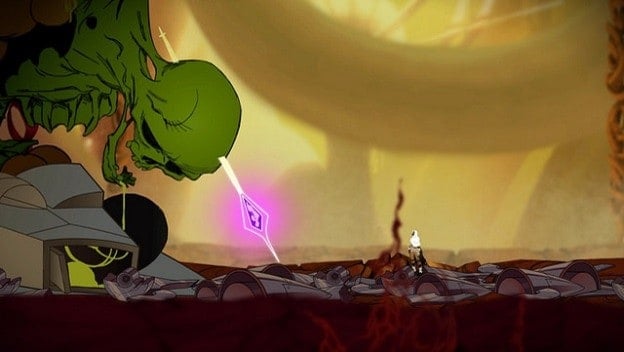I’ve been crushing on a new game lately. It’s called Sundered , and it looks beautiful. Sundered is being developed by ThunderLotus, the indie studio that brought us Jotun , and it’s clear that their second offering is more ambitious in scale and direction. Sundered features hand-drawn art, a darker tone inspired by Lovecraft’s writings, more complex combat, and “endless replayability.”
Did I mention that the game looks beautiful and features hand-drawn art? Just look at this trailer:
Sundered was just revealed on the official PlayStation blog, and will be headed to PS4 and PC some time next year. I was delighted to finally learn more about the gameplay which, in the developer’s words, “…can mostly be described as a replayable Metroidvania, close to Rogue Legacy and Super Metroid. You explore an ever-changing dungeon, fight hordes of eldritch horrors, and choose between humanity or madness.” Sign me the f#*k up.
I was so ready to hype this game up and sell it to all of my friends. I was ready to mark the impending release date on my calendar. I was going to stalk Limited Run Games and beg them for a phyiscal version. That is, until I saw these two words in the list of features: “Procedural world.” There it is. Those two words completely shattered my hopes and dreams.
The term “Metroidvania” is thrown around so flippantly now, but when older gamers see it, it evokes certain expectations. I expect a Metroidvania to play out across an enormous, masterfully designed map. I expect that map to be full of secrets. I expect some or most of those secrets to be inaccessible until I discover other secrets. In a Metroidvania, the more I explore the more power I get; the more powerful I get, the more I can explore. The map is the key to it all – the lure, the challenge, and the reward.

That is what I was looking forward to. A true Metroidvania with this gorgeous and terrifying aesthetic. Do you see now why the words “procedural world” fill me with so much pessimism? How can the map be the star of the show when it’s created semi-randomly? There are very few great games that feature procedurally generated worlds. Binding of Issac and Spelunky are the only two that come immediately to mind. There was one other game that was supposed to showcase the full potential of a procedurally generated universe – a game that was supposed to keep us captivated forever. You already know what I’m talking about, don’t you?
No Man’s Sky has ruined the term “procedurally generated” for most of us. Hello Games’ algorithm was so hot they were almost sued for it. It was the fact that worlds and creatures could be produced on the fly that made the game so appealing before it was released. Now the Steam version is making headlines for boasting less than 1000 concurrent players a month after launch. We now equate “procedural” with “forgettable.”
I’m willing to be surprised by Sundered . In fact, I’m hoping to be. But unless I’m missing something, I just don’t see how you can create a true or successful Metroidvania-style game with a procedural world. The two ideas seem to me to be mutually exclusive. Let’s hope that I’m wrong.
